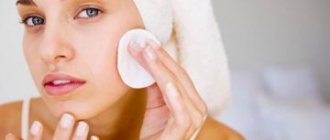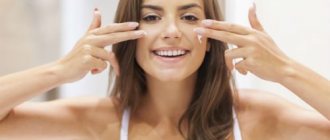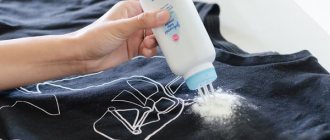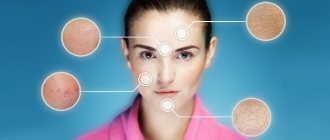Features of children's skin
The child's sebaceous and sweat glands are formed from birth, but the first years of life work poorly. Due to their insufficient activity, the protective layer is thin and permeable to microorganisms and chemical molecules. The connection between the upper layer of the epidermis and the underlying dermis is weak, so children under 10 years of age are more likely to experience allergies and inflammation.
A study by the Johnson & Johnson Children's Science and Technology Center confirmed that a child's skin is 20-30% thinner than an adult's skin. It is looser: the cells forming the stratum corneum are less connected to each other. There is more water than fat in the composition: this makes the skin sensitive to irritants. In children of the first years of life, the ratio of weight to body surface is 1.5 times greater than in adults. Therefore, the concentration of substances in the child’s blood is higher when using the same amount of cosmetics.
During adolescence, the skin changes: the sebaceous glands work more actively, the pH shifts to the alkaline side. An oily sheen, closed and open comedones appear.
“During puberty, due to hormonal changes, the qualitative composition of sebum changes, creating a nutrient medium for microorganisms. The local immunity of the skin decreases, bacteria, viruses and fungi multiply more actively, and rashes appear more often,” says Nadezhda Nabatnikova, a dermatovenerologist and podologist at the GMS clinic.
How is the skin different in these two parts of the female body?
Morphologically - of course, nothing. Moreover, it is even the same everywhere. Both skins consist of the same layers and a fatty layer under the skin... But in principle, any skin is “equipped” with a number of special features that are important to know when caring for it.
Features of the skin on the face.
The majority of women pay much more attention to the skin of their faces than to the skin of their hands. And she deserves it. Because it is the skin of the face that is forced to endure the shortcomings of the external environment to the maximum. But at the same time it can hardly be called homogeneous. The thinnest skin on the face is located on the eyelids...
Features of the leather on our hands
It is much more subtle. This is how nature created it. Accordingly, she ages faster. And it is not just words. Most often this is actually true. The skin of the hands contains almost no sebaceous glands. It follows from this that it is less protected than the skin on the face. In addition, the hands of an ordinary woman are tested every day. They are forced to wash, iron, and stay in the sun for a long time. But many people simply forget to do this with gloves, or in the case of the sun, to apply a special cream. Just like applying cream to protect them.
Those who read or watched the film “Gone with the Wind” probably remember the episode when Scarlett sewed a more beautiful dress especially for a date with Rhett Butler in order to convince him of her well-being. But Rhett only had to look at her in Scarlett’s hands (worked out, that is, the hands of a far from rich woman) to understand how things really were.
At what age can you wear makeup?
The charitable organization Renfrew Center Foundation, together with Harris Interactive, conducted a survey among girls from 8 to 18 years old. It turned out that 58% of girls regularly use decorative cosmetics, more than 50% of them started wearing makeup at the age of 11-13, and 15% tried makeup for the first time before the age of 8.
“Products for children have an age marking on the packaging, you can use it as a guide. But decorative cosmetics contain pigments, fragrances and preservatives that can cause allergic reactions. Therefore, we use special children’s products no earlier than 3 years, provided that there are no skin problems. “Adult” cosmetics can be used from the age of 12,” emphasizes Nina Sergeeva, dermatovenerologist at the Fantasy clinic.
Early use of decorative products harms the body: this is confirmed by a study by scientists at the University of California, Berkeley. They took urine tests from girls who regularly used cosmetics. After which they asked the participants in the experiment to stop using it for a week.
The results showed that the concentration of chemicals in the urine of the subjects (phthalates, methylparabens, propylparabens, etc.) decreased by 45.4% compared to the initial value.
Hand and body creams: can you use them on your face?
The cosmetics industry produces hundreds of all kinds of jars with products for caring for the skin of the face, body and hands in the form of creams. Despite this, many to this day believe that there is no need to smear different parts of the body with creams “supposedly” specially designed for them. That is why the question “is it possible to smear body and hand cream on your face if their compositions are almost the same?” is heard more and more often. To get the right answer, you need to carefully analyze the effect of the cream on the face, body, hands...
What to avoid in ingredients
Harmful components of decorative cosmetics:
- Bentonite is a porous clay made from ash of volcanic origin. Used in powders and foundations. Absorbs water from the skin, forms a film on the surface and clogs pores.
- Phthalates are cosmetic solvents. Contained in hair and nail polishes, lipstick, mascara. A study by scientists at the Icahn School of Medicine found that phthalates cause early puberty in girls.
- Microcrystalline wax - paraffin obtained from petroleum, is part of lipsticks. Causes allergic reactions: rash, redness of the skin.
- Imidazolidinyl urea is a preservative used in powders, eye shadows, and baby shampoos. Breaks down to the toxic carcinogen formaldehyde.
- Mineral oil and its derivatives. They form an oily film on the skin, leading to acne and allergic rashes.
- Aminomethyl propanol is a gelling agent and emulsifier contained in mascara. Causes irritation to skin and mucous membranes.
In 2022, the US Food and Drug Administration banned the sale of Claire's and Justice brand children's beauty products. According to the results of the examination, asbestos was found in their composition - a substance from the first group of carcinogens that reliably causes cancer in humans.
What are the functional features of each cream?
If we talk first about the hand cream, it has only 3 functions: softens the skin, protects it, and nourishes it. You may have objections to this because stores have a much larger assortment of hand creams. For example, whitening, anti-aging, and many others. etc.
But, if you try to compare the compositions of all these creams, you will most likely be surprised. The ingredients are similar. The only difference is this:
- In the scent
- How much glycerin do they contain?
- Do they contain hydroquinone? This ingredient is found in whitening creams and is banned in most countries.
If we are talking about face care creams, then they contain a huge number of components that are radically different from the composition of hand care creams. Below we provide just a few examples to help you understand.
Briefly about each type of cream that is applied to the hands
1. Moisturizing
The majority of creams produced around the world belong to this type. They contain more water than fat. That's why they absorb into the skin so quickly and don't leave a greasy film.
2. Nutritious
This type of cream is much thicker. The reason is that they contain several times less water. It nourishes the skin well and restores its elasticity. You can apply the cream as a mask. How often? Depends on the condition of your skin.
3. Protective
This cream will especially appeal to those ladies who do not like to work with gloves. An essential component of such creams is silicone. It creates a kind of protective film between the skin of your hands and the environment (for example, household chemicals when working around the house, or soil when working in the garden, etc.)
By the way, if you want to save money and space on the bathroom shelf, you can use body care cream or milk instead of moisturizer.
Briefly about some types of creams that need to be applied to the face
1. Nutritious
A good cream of this type is always the key to healthy skin, no matter what time of year it is outside. This day cream protects and has a thicker texture. Night time restores and rejuvenates.
2. Moisturizing
It is necessary for every skin type, whether it is dry, oily, normal, or even mixed. In order to choose the right one, many factors should be taken into account. Age, time period at the moment, that is, what time of year), skin characteristics, sensitivity, even lifestyle. Even gender matters. Yes, yes, men need moisturizer too.
3. Whitening
This type of cream is used in truly necessary cases. Its action is to remove the thinnest layer of the epidermis. It makes the skin thin, vulnerable to various negative environmental influences, and defenseless to this influence.
Is it possible to use my mother's cosmetic bag?
Decorative products for adults cause allergies, redness and rashes in the child. The concentration of fragrances, preservatives and pigmenting substances in them is higher than in children's cosmetics: this is necessary for the durability of makeup. Some foundations and concealers
“Such decorative cosmetics are designed for the adaptive capabilities of fully formed skin. Adults have a thicker stratum corneum, the skin is less sensitive, and it contains enough enzymes and lipids. Adult cosmetics have slightly different tasks: they must be long-lasting, so they contain bright pigments and have a denser texture,” says Sergeeva.
Mom’s cosmetic bag also contains waterproof products based on wax, alcohol and silicone. To remove them, you have to rub your face: this traumatizes children's skin, causing irritation, dryness and microcracks.
Cosmetics and makeup brushes are a source of viruses and bacteria. Using the same mascara, eyeliner or lipstick with the mother, the child becomes infected with a staphylococcal infection, herpes or conjunctivitis.
What do people on the forums think?
The opinions of people on the forums are mostly similar to ours. It varies only from the strict “not allowed, because the skin on my hands and face is completely different” to “I apply it, but in theory it’s not recommended.” There are also detailed answers. For example, the majority of hand creams contain silicone. In principle, nothing bad will happen most often if you smear hand cream on your face, but you don’t need to do this systematically.
There are also universal creams that can be applied to any area, but they are rarely found in stores.
Attention!
There are opinions on the Internet that these two creams are interchangeable, but this point of view is very doubtful.
Cream is also a chemical
Agree, you don’t use high-quality organic cosmetics; only a few can afford such a luxury. And any, even the most expensive night cream is synthetic components and additives that accumulate in cells and turn into the very toxins that we all so zealously get rid of by any means.
It turns out to be a contradiction: we adhere to a healthy diet, drink cleansing cocktails and vitamins for youthful and healthy skin, do scrubs and deep cleanses, and then we ourselves smear on our faces what we got rid of. Whatever one may say, chemistry remains chemistry, and it is not useful; the skin needs a break from it.
Results and conclusions
Therefore, answering the question in the title, we answer firmly: do not do this under any circumstances! Moreover, even if you decided to take a risk and apply hand cream to your face and did not see any problems, this does not mean that they will not appear later.
Applying hand cream to your face can lead to serious consequences just once. Of which, irritation will be less. Large amounts of emollients can cause facial swelling and severe allergies.
Therefore, if a cream is labeled “for hands,” it should be applied exclusively to the hands. As a last resort, on your feet. The structure of the skin on the feet is at least somewhat similar to the structure of the skin on the hands. But on the face... Under no circumstances should you do this. It won't bring any benefit.
Application technique
Want to get more benefits from simply applying cream? Then apply it according to the techniques from the “Boldly NOT” marathon. Thanks to exercise, the skin absorbs vitamins more actively, and wrinkles literally disappear.
Does it ever happen to you that you are too lazy to regularly apply cream not only once, or even twice a day? Or you just can’t bring yourself to do it, because your skin isn’t in such a terrible state yet? Think about skipping care for just a day or two? But it is in regularity that success lies. To do this you need to develop a habit. It has been proven that in order to instill a healthy habit in yourself, you need to repeat the action for 21 days. Our basic marathon “SmeloNET” lasts just that long.
Common mistakes when applying cream to the face
We are sure that everyone has made at least one of these mistakes at least once. But nothing, thanks to this article the situation can be corrected. Answer a few questions:
- Have you applied the product to uncleaned skin?
- Did you apply it haphazardly, without following the massage lines?
- Did you use the night cream in the morning and the day cream at night?
- Did you apply too much product to your skin?
- Didn’t you wait until the product warmed up a little, but rubbed it cold?
- Did you apply the product too often or, conversely, neglect the procedure?
- Did you apply the night cream directly five minutes before bedtime?
If the answer to at least one of these questions is yes, then you should immediately correct the situation.
How to choose cosmetics correctly?
To maintain your child’s health, you need to take the choice of children’s cosmetics seriously:
• Study compositions. If you come across an incomprehensible name, a dictionary and online translator can help. • Pay attention to expiration dates and age restrictions indicated on the packages. • Test products for allergic reactions. If the child is allergic, and the package does not have the “hypoallergenic” marking, you should refuse to purchase. • Avoid products with a strong odor, unnaturally bright color, or uneven texture. • Choose decorative “paints” in neutral shades, purchase makeup removers. • Consult and discuss purchases with your daughter. If tastes do not coincide, look for compromises, explain, and justify your choice. • Skip dubious sites and adult cosmetics stores.
After purchasing the product, you should follow the manufacturer’s storage recommendations - observe the temperature regime, protect from sunlight. Careful attention to the selection, use, and storage of children's cosmetics is the key to safety for the child.
What cosmetics does a child need?
Children's products include cosmetics from 0 to 14 years. According to their purpose, they are hygienic (caring), protective, medicinal, and decorative. How many goods does a child need? Parents decide until the child “grows” with his taste preferences. Modern hygiene products for babies and children's cosmetics can be divided into several categories.
Caring cosmetics include: • soap, shower gel, shampoo, toothpaste; • baby bathing products, powder, wet wipes; • oils, creams, lotions.
The category of protective products includes: • repellents in the form of cream; • hygienic lipsticks, lip balms; • sunscreen milk with SPF index 20-60.
To create make-up, girls need: • foundation; • Mascara; • lip gloss or lipstick.
Cosmetics with a therapeutic effect are: • dermatological creams (ointments); • anti-acne lotions for teenagers.
Children's nail polishes and perfumes deserve attention. Girls' nail plates are thin, elastic, with soft cuticles. Therefore, you need to use varnishes based on fruit resins that do not contain aggressive substances. Perfume for young fashionistas should not sound “grown-up” or contain a large percentage of alcohol or toxic fragrances.
Opinions of parents and psychologists about children's makeup
The need for hygienic care and protection of children's skin from ultraviolet radiation or frost is not in doubt among parents. Pediatricians recommend using caring and protective products from the first days of a baby’s life. Soap, shampoo, cream are part of a child’s daily hygiene, a guarantee of health, and a way to form healthy habits. Another thing is children's decorative cosmetics. At what age can a girl wear makeup? What makeup products should I buy for my little princess? Questions are periodically raised on the Internet on forums for young mothers.
A comparative analysis of opinions conducted by experts revealed an ambiguous attitude towards children's makeup. The arguments of opponents of the use of decorative cosmetics at a young age were:
• Harmful to delicate skin. Parents believe that there are no safe “paints” for the face. This is just a publicity stunt to increase sales. • The dangers of early adulthood. A girl wearing makeup looks and feels older than her age, which means she can do stupid things. • Formation of incorrect priorities in the child. The pursuit of an attractive appearance infringes on the development of the inner world and spiritual values.
Parents who allow girls to wear makeup put forward their own arguments in favor of children's makeup:
• GOST 32117-2013 requirements for the composition of cosmetics for children. If you buy certified products that are sold in pharmacies, the child’s health will not suffer. • Cultivation of taste, elegance, femininity. Taking care of her appearance, the young lady learns to look impressive and follow fashion trends. • Maintaining contact with your daughter. Bans cause protests and spark increased interest. If you prohibit wearing makeup, a small child will be capricious and cry, and a teenage girl will begin to wear makeup secretly from her parents.
Psychologists are not opposed to the use of children's decorative cosmetics, but they advise defining the boundaries of what is permitted:
• No make-up until 3-4 years old. At this age, you can apply festive makeup to your child for a matinee or other event. Cosmetologists do not recommend wearing makeup regularly. • The contents of a girl's cosmetic bag should be under mother's control. No concessions, no matter how much the child asks to buy “adult” lipstick or mascara. • It is important to maintain priorities so that “decoration” does not turn into a mania and does not crowd out other interests. • Mom’s responsibility is to teach how to use makeup correctly and emphasize natural beauty.
Features of application to the neck and area around the eyes
Avoid using heavy or moisturizing products around the eyes as they may irritate the eyes. The skin around the eyes is very thin and delicate. This area loses more moisture than all others, so it is prone to dryness. First you need to choose your product. Do you want to get rid of wrinkles and crow's feet? Choose products with retinol or peptides. Need something to combat dark circles? Then products with niacinamide or caffeine will help.
How to apply:
- Squeeze some cream onto your little fingers.
- Distribute the product pointwise along the bony edge of the upper and lower eyelids.
- You can drive the product in with light patting movements along the upper zone from the inner to the outer corner and back - from the outer to the inner along the lower zone. The same can be done with stroking movements.
Never forget about your neck. She really shows her age. Even if you do exercises, self-massage and use a variety of facial products, if you don’t pay attention to your neck, it’s all in vain.
- Cleanse your skin.
- As with any other area, warm up the product. Check if the skin type of your face and neck matches. If not, you need to purchase a suitable product. You can use either a moisturizer or a special one specifically for this area.
- The product should be applied from the middle of the neck from bottom to top, moving the palm to the side of the neck and back. This produces semicircular movements.
Remember that using good and suitable cosmetics is only 10 percent of the success on the path to radiant, smooth skin. The main thing in this matter is regular exercise and self-massage. Without them, it is impossible to achieve an even skin tone and healthy complexion. Come to the “SmeloNET” marathon, take a photo before the marathon and after three weeks of regular classes. The difference will amaze you. Read more below.
Breast care during pregnancy
As a rule, everyone is ready for the fact that during pregnancy the breasts become larger - on average by 1 - 2 sizes. Her weight increases, and the ligaments cannot cope with the increased load. After breastfeeding is completed, it may become larger or smaller, everything is individual.
But if its size cannot be influenced, then is it possible to prevent the change in shape? Also, many women note that during pregnancy and childbirth, the nipples become larger and darker. Breast sensitivity may change during this period. What to expect?
1. As for the nipples, their size may decrease after breastfeeding ends, they may become lighter, but in each case everything is individual. The sensitivity of the nipples, as a rule, returns to the state it was before pregnancy.
2. Experts say that it is impossible to prevent changes in breast shape. This is a natural phenomenon. Here are some remedies you can resort to to make your breasts firmer:
2.1.1. after consulting with a specialist, do planks and other special exercises - they affect the pectoral muscles, and not the breast tissue, but nevertheless they can have an effect;
2.1.2. breast massage combined with almond, coconut or olive oil will improve skin tone. You need to be careful not to massage the nipple area, so as not to stimulate the production of oxytocin, which can cause uterine tone. It is recommended to do it about three times a week;
2.1.3. good posture, which can be achieved through yoga and gymnastics - as a result, the shape of the breasts improves;
2.1.4. It is recommended to wear special underwear, first of all, for comfort - during pregnancy, the breasts increase in size and need additional support.
Cosmetologists' opinion
Most cosmetologists are of the opinion that hand cream should not be applied to the face area even once. This is true for oily and combination skin, which can “respond” by clogging pores and worsening the inflammatory process. Dermal breathing is disrupted, and the number of acne increases.
- It is allowed to use a product whose packaging states “Cream for hands, nails and face . This product is light, water-based, softening or moisturizing, but does not solve age-related problems and does not fight acne. Suitable for daily care, but if there are imperfections, you need to use additional products.
Even a soft hand cream , for example “Velvet Hands” or for children, should not be applied to the skin of the face. Here the volume of glycerin is increased, it dries the skin, and with regular use it causes early aging and the appearance of wrinkles. Do not apply foot cream to your skin.
Areas of application of hydrocosmetic products
Hand cream is used to protect and restore from external influences , prevent premature aging, eliminate germs, reduce dryness and chapped condition.
Face cream acts as a moisturizing, mattifying, nourishing, protective, cleansing agent . It is able to restore dry water balance, eliminate shine of combination or oily skin, and cleanse pores of impurities.
So, is it possible to put hand cream on your face?
Cosmetologists and dermatologists do not recommend substituting skin care products due to differences in the skin, composition and areas of application of cosmetic products.
However, each woman makes her own decision.
Which cosmetics to choose?
The priority is safety. If a woman is used to choosing cosmetics for herself empirically, this method is not suitable for children. You need to learn to understand the composition of each product. Knowledge of harmful components will help protect your child from allergies, irritation, intoxication, and indelible stains.
Children's cosmetic products should not contain:
• Parabens, benzophenones. If the composition contains Propylparaben, Isopropylparaben, Benzylparaben, Benzophenone, the product cannot be purchased. • Boric acid, iodopropynylbutylcarbamate (IPBC). Substances are not allowed to be added to products for children under 3 years of age.
It is highly undesirable to have:
• lauryl, sodium laureth sulfate (sodium lauryl-, laureth sulfate) - surfactants; • emulsifiers and foaming agents, which are hidden under the abbreviations MEA, DEA, TEA; • polyethylene glycol (PEG/PPG) in an amount >10%; • petroleum products - petrolatum, crystalline paraffin; • lanolin; • bentonite – clay; • mineral oil (MINERAL OIL); • triclosan (triclosan); • preservative phenoexitanol (phenoxyethanol).
Cosmetic and hygiene products that are safe for children are made from herbal extracts, vegetable oils, and thermal water.
Cream or lipstick for a young fashionista may contain the following substances:
• jojoba, shea or coconut oil; • glycerin; • isododecane - solvent; • vitamins A and E; • extract of calendula, chamomile or aloe vera.
Dyes must be natural. The sunscreen milk contains a harmless amount of zinc oxide and titanium dioxide.
Is it possible to wipe your face with chlorhexidine?
To treat problematic dermis, you can use chlorhexidine. The drug penetrates deeply into tissues and quickly destroys harmful bacteria. Teenagers suffering from facial acne can cure them with this wonderful solution.
You can wipe your face only 2 times a day, but not more often, otherwise you will get rid of beneficial microorganisms. Moreover, the concentration of chlorhexidine should be 0.5% so as not to dry out the epidermis.
To cause the death of harmful microbes, you can make a mask with black clay:
- clay – 1 tsp,
- 0.01% chlorhexidine solution - 2 tsp.
Apply the mixture to the skin and leave for 15 minutes.
Pain relief mask with aloe
Worried about your chapped face? What to anoint your skin with to avoid discomfort? The juice of the plant has unique properties. Using them you can reduce the pain that occurs as a result of chapping of the skin. To prepare a healing mixture, you need to grind one aloe leaf to a mushy state. Then you should add one more component - 1 teaspoon of olive or sea buckthorn oil.
Distribute the mixture over the damaged areas and leave to act for half an hour. Remove the mask with a napkin and wash with warm water. To achieve the fastest possible result, this procedure must be repeated 2 times a day. This will help you get rid of painful sensations in the shortest possible time.
Is it possible or not?
Women are different: some, without any fear for their skin, periodically use a tube of baby cream on their face, while others are afraid of such experiments. And it is difficult to answer unequivocally the question of whether it can be used by adults.
However, this product has its pros and cons.
The main advantages of baby creams include:
KK Adapt. 5 paragraph
- their hypoallergenic properties;
- production based on natural and natural ingredients;
- their tightening properties, making the skin more elastic and firm;
- relieving signs of inflammation;
- protection from harmful external factors.
Despite these benefits, long-term use of baby cream is not recommended, otherwise you will have to face a number of problems.
- Firstly, the skin may be contaminated with toxins, resulting in inflammation, acne and swelling.
- It is also possible that the skin will become more sensitive and begin to peel off.
It is important to understand: baby creams are not suitable for combating age-related skin changes, so there is no point in using them to get rid of wrinkles, etc. Sometimes it can be applied to chapped skin, but only in small quantities
Cleansing face before application
In order for the skin to receive the maximum amount of nutrients from the cream, it must be cleansed.
Even if you apply the product in the morning, you still need to clean it.
How to properly cleanse your face:
- To begin, wash your hands well and wash your face with warm water.
- Apply a toner suitable for your skin type to a cotton pad and wipe your face. The toner helps restore skin pH and tighten pores. If it is dry or sensitive, then choose a toner without alcohol.







